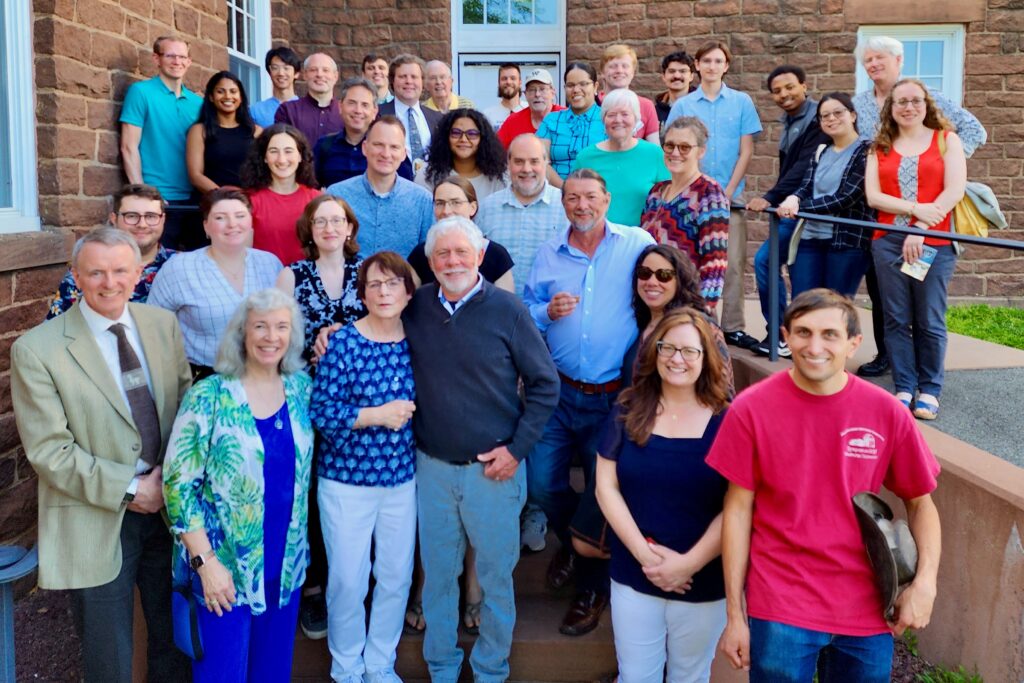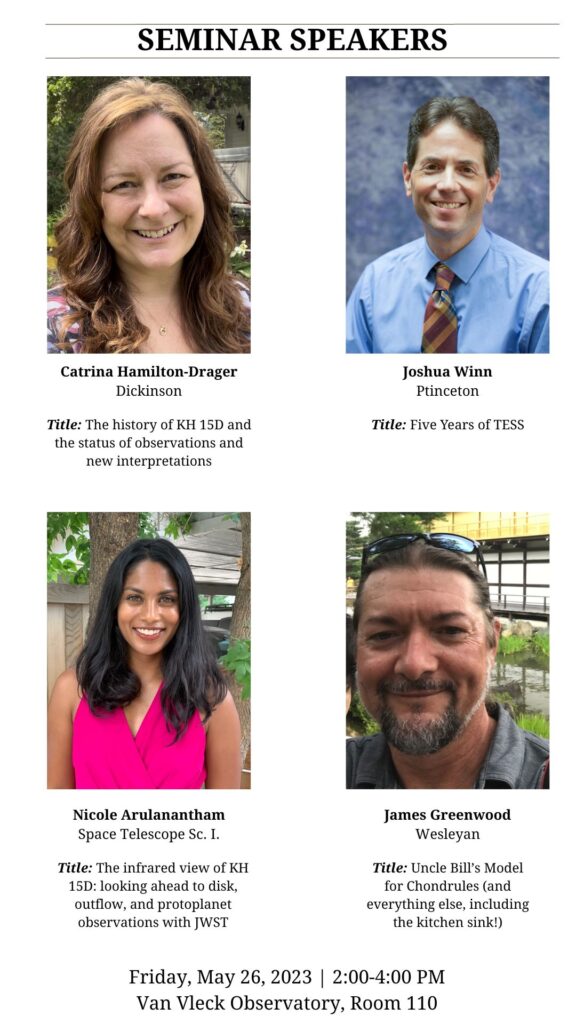This fall, the Wesleyan Astronomy Department welcomes one new professor and two postdoctoral researchers to the Van Vleck Obsevatory.
Professor Sarah Wellons (she/her) uses powerful numerical simulations to explore how galaxies evolve, and why they look the way they do. She is teaching ASTR 210 this fall, a course teaching future or current majors how to utilize scientific computing in an astronomy context.
Dr. Jonathan Jackson (he/him) is a Teaching Fellow who also work with Professor Seth Redfield on planetary dynamics. He is teaching a First Year Seminar this fall – ASTR 102F – about planetary formation, evolution, and the possibility for life on life on other worlds.
Dr. Azmain Nisak (he/him) is a Postdoctoral Researcher who is also working with Professor Redfield. His current work focuses on gaining more information on clouds in the Milky Way’s interstellar medium (ISM).
In order to get to know our new members, we asked them a few questions about how they got to Wesleyan, what they do here, and how they are enjoying their time here so far.
- What was your academic journey leading up to this position at Wesleyan?
Sarah: I was an undergraduate at Princeton, where I majored in Astrophysical Sciences and got a certificate (sort of like a minor) in Applications of Computing. For my undergraduate thesis, I used particle-in-cell simulations to study relativistic shocks in plasmas (with application to gamma-ray bursts). I then went to Harvard for graduate school, where I worked on GRMHD simulations of black hole accretion disks for my master’s and then moved to galaxy formation simulations for my PhD work. My dissertation was about the formation and evolution of massive compact galaxies and the way that galaxy populations evolve over cosmic time. After grad school, I spent 5 years at Northwestern University as a postdoc (first as a CIERA fellow and then as an NSF Astronomy & Astrophysics fellow), where I continued my work using simulations to study how massive galaxies form, evolve, and quench at high redshift. During my time as an NSF fellow, I also worked with the Northwestern Prison Education Program to teach introductory astronomy to students incarcerated in Illinois state prisons.
Jonathan: I studied astronomy and astrophysics as an undergraduate at Harvard University before going to graduate school at Penn State for astronomy as well. I defended my PhD dissertation in June of this year before coming to Wesleyan.
Azmain: I have been fascinated by stars, planets, and the Universe beyond Earth for as long as I can remember. I completed my Bachelor of Science (BSc) degree in Physics at the City College of New York (CUNY CCNY), where I conducted research with Professor Swapan Gayen to study the spectroscopic properties of impurity-ion doped insulators with lasers. I completed my Master’s degree and Ph.D. in Astronomy at Georgia State University (GSU), where I worked with Professor Russel White to study young star clusters and possible planets orbiting their Sun-like stars using Gaia astrometry, as well as CHIRON and GOODMAN spectroscopy.
- What are you most looking forward to during your time at Wesleyan?
Sarah: I am really looking forward to working with students, in both teaching and research! Seeing students learn how awesome the Universe is for the first time helps me remember how awesome it is too.
Jonathan: I’m most looking forward to working with students on new and exciting research projects. Starting research can be a very intimidating process, but a lot of scientists can point to their first research project (and their first research mentor!) as a major piece of their decision to continue in the field. I’d like to help budding astronomers build those experiences.
Azmain: I am most excited to work with Professor Redfield on new projects related to the Interstellar Medium (ISM) and Exoplanets. I believe our collective expertise will be wonderful for making progress in these fields.
- Can you tell me a little bit about your current research?
Sarah: Currently, I am spending a lot of time thinking about the physical relationship between galaxies and the supermassive black holes (SMBHs) they host. We know that they co-evolve, and we suspect that the powerful winds and jets emitted by accreting black holes might be responsible for quenching star formation in massive galaxies, but the exact nature of the interplay between them is unclear. We are working on incorporating models for SMBH physics into our galaxy simulations and understanding how our modeling choices affect our predictions for how galaxies evolve.
Jonathan: I study the dynamics of planetary systems, with a particular focus on orbital architectures. I’d like to understand how the planets we observe found their way onto their current orbits and why so many exoplanetary systems look dramatically different from the Solar System.
Azmain: Currently, I am working on an ongoing survey of the local ISM called SNAP. This project uses sightlines to the nearest stars to infer the presence and properties of interstellar clouds based on absorption of Mg II, Fe II, and Mn II doublet lines in Hubble Space Telescope (HST) spectra. I am excited to be working on this project because it is a new topic of study for me, and I am analyzing the third and largest batch of data from this set, which includes a whopping 45 sightlines!
- What advice would you give to someone considering going into research?
Sarah: If you are potentially interested in a research career, start getting your hands dirty as soon as you can! It’s a very different experience than classwork. Try to get some experience in a few different subfields so you can get a sense of what the day-to-day work is like, which will help you decide if it’s what you want to do long-term. I think it’s important to get a sense of the breadth of types of research that astronomy has to offer – for example, I did a couple of observationally-oriented summer projects as an undergraduate, which made clear to me (with no offense to my colleagues, of course!) that observational work wasn’t for me and that theory/simulation was where my strengths and interests lay.
Jonathan: Try something that excites you! No matter what area of research you choose, you’ll pick up skills that will help you out later on, but passion for the subject matter and a good relationship with your research mentor will ensure your experience is as rewarding as possible.
Azmain: One piece of advice I would give to someone considering going into astronomy research is to stay calm when encountering a roadblock. It may be tempting to panic when you had a plan of how to do something but then it inexplicably failed. Give yourself time, be prepared to try various solutions, and don’t be afraid to ask for help if you need it. And don’t personalize failure or feel like you are inferior to your peers when you get stuck. Odds are, they are getting stuck a lot too. Solving a problem after getting stuck over and over is one of the reasons why doing astronomy can be so rewarding!
- Favorite thing about Middletown/Connecticut so far?
Sarah: After a decade of city living, I am really enjoying the peace and quiet and access to nature that a smaller town offers! Getting produce from local farmstands and watching the leaves start to turn have been particular joys so far.
Jonathan: The weather! Early autumn in New England is beautiful and Middletown is an excellent place to walk around and enjoy the scenery.
Azmain: My favorite thing about Middletown and Connecticut so far is how beautiful they are! There are definitely a lot more trees than in NYC or Atlanta that’s for sure.
-Post written by Alaina Einsig


























































